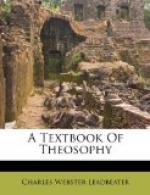This substance is perceptible only to highly developed clairvoyant power. We must assume a time (though we have no direct knowledge on this point) when this substance filled all space. We must also suppose that some great Being (not the Deity of a solar system, but some Being almost infinitely higher than that) changed this condition of rest by pouring out His spirit or force into a certain section of this matter, a section of the size of a whole universe. This effect of the introduction of this force is as that of the blowing of a mighty breath; it has formed within this aether an incalculable number of tiny spherical bubbles, [The bubbles are spoken of in The Secret Doctrine as the holes which Fohat digs in space.] and these bubbles are the ultimate atoms of which what we call matter is composed. They are not the atoms of the chemist, nor even the ultimate atoms of the physical world. They stand at a far higher level, and what are usually called atoms are composed of vast aggregations of these bubbles, as will be seen later.
When the Solar Deity begins to make His system, He finds ready to His hand this material—this infinite mass of tiny bubbles which can be built up into various kinds of matter as we know it. He commences by defining the limit of His field of activity, a vast sphere whose circumference is far larger than the orbit of the outermost of His future planets. Within the limit of that sphere He sets up a kind of gigantic vortex—a motion which sweeps together all the bubbles into a vast central mass, the material of the nebula that is to be.
Into this vast revolving sphere He sends forth successive impulses of force, gathering together the bubbles into ever more and more complex aggregations, and producing in this way seven gigantic interpenetrating worlds of matter of different degrees of density, all concentric and all occupying the same space.
Acting through His Third Aspect He sends forth into this stupendous sphere the first of these impulses. It sets up all through the sphere a vast number of tiny vortices, each of which draws into itself forty-nine bubbles, and arranges them in a certain shape. These little groupings of bubbles so formed are the atoms of the second of the interpenetrating worlds. The whole number of the bubbles is not used in this way, sufficient being left in the dissociated state to act as atoms for the first and highest of these worlds. In due time comes the second impulse, which seizes upon nearly all these forty-nine bubble-atoms (leaving only enough to provide atoms for the second world), draws them back into itself and then, throwing them out again, sets up among them vortices, each of which holds within itself 2,401 bubbles (49^2). These form the atoms of the third world. Again after a time comes a third impulse, which in the same way seizes upon nearly all these 2,401 bubble-atoms, draws them back again into their original form, and again throws them outward once more as the atoms of the fourth world—each atom containing this time 49^{3} bubbles. This process is repeated until the sixth of these successive impulses has built the atom of the seventh or the lowest world—that atom containing 49^{6} of the original bubbles.




